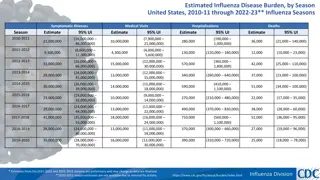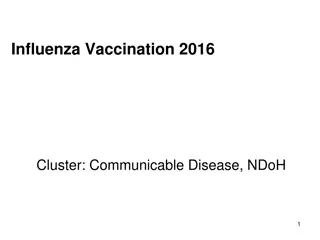Impact of Highly Pathogenic Avian Influenza 2023 on South African Broiler Industry
The presentation by the South African Poultry Association sheds light on the detrimental effects of Highly Pathogenic Avian Influenza (HPAI) on the broiler industry in South Africa. Factors such as load shedding, water supply interruptions, and now, the outbreak of H7N6, have exacerbated the financial distress faced by broiler farmers. With millions of birds culled and a significant impact on broiler breeding stock, the industry is facing unprecedented challenges that require urgent attention and support.
Download Presentation

Please find below an Image/Link to download the presentation.
The content on the website is provided AS IS for your information and personal use only. It may not be sold, licensed, or shared on other websites without obtaining consent from the author.If you encounter any issues during the download, it is possible that the publisher has removed the file from their server.
You are allowed to download the files provided on this website for personal or commercial use, subject to the condition that they are used lawfully. All files are the property of their respective owners.
The content on the website is provided AS IS for your information and personal use only. It may not be sold, licensed, or shared on other websites without obtaining consent from the author.
E N D
Presentation Transcript
Highly Pathogenic Avian Influenza 2023 Portfolio Committee: Agriculture, Land and Rural Development Presentation by the Broiler Organisation: South African Poultry Association General Manager: Izaak Breitenbach Friday October 20, 2023 Small footprint. Big impact.
History of HPAI in South Africa History of HPAI in South Africa Broiler industry in financial distress due to load shedding, water supply interruptions, infrastructure failures, inflation in energy costs and high feed input costs .now bird flu. Year 2017 2021 2023 Birds Culled 2,5 million 3,0 million 7,5 million Strain H5N8 H5N1 H5N1 & H7N6 13 million birds culled as a disease control measure with no compensation under the provisions of the Animal Diseases Act. Small footprint. Big impact.
History of HPAI in South Africa History of HPAI in South Africa DALLRD Report 29th September 2023 Small footprint. Big impact.
Current Outbreak of Concern: H7N6 Current Outbreak of Concern: H7N6 Small footprint. Big impact.
HPAI 2023 focusing on the Broiler Impact HPAI 2023 focusing on the Broiler Impact Number of Broiler Breeder birds culled: >2,5 million broiler breeders (Parent Stock) 30% of national flock Greater Gauteng - 95% of all broiler breeders culled Small footprint. Big impact.
HPAI 2023 Impact on Broiler Breeding Stock HPAI 2023 Impact on Broiler Breeding Stock 22 weeks 40 weeks 3 weeks 22 weeks 33 days 40 weeks 3 weeks Rearing Laying Hatching Rearing Growing Laying Hatching Grand Parent Farms Parent Farms Broiler Farms Processing Retail Parent Breeding and Broiler Rearing Grand Parent Breeding Processing and Consumer Bird flu impact in the integrated broiler production chain - culling of infected broiler breeding parent stock Small footprint. Big impact.
Epidemic Curve by Farm Type Epidemic Curve by Farm Type Small footprint. Big impact.
Provinces affected by the H7 Strain Provinces affected by the H7 Strain Small footprint. Big impact.
Municipal Districts affected by the H7 Strain Municipal Districts affected by the H7 Strain Small footprint. Big impact.
Impact: reduced day Impact: reduced day- -old broiler chicks hatched old broiler chicks hatched (chicks per week) (chicks per week) Small footprint. Big impact.
Impact: reduced broiler production Impact: reduced broiler production (birds per week) (birds per week) Short-term impact & recovery: industry contingency plans . Small footprint. Big impact.
Contingency plans for broiler hatching egg shortfall Contingency plans for broiler hatching egg shortfall (broiler industry (broiler industry - - mitigating factors) mitigating factors) Extending the depletion age of national broiler breeder flock placements provides more hatching eggs for day-old chick production Setting eggs from younger flocks in the national broiler breeder program provides more hatching eggs for day-old chick production Reduced the export of broiler hatching eggs provides more hatching eggs for local supply Relax the criteria around the grading of broiler hatching eggs at the hatcheries provides more hatching eggs for day-old chick production Import broiler hatching eggs (current estimates >53 million hatching eggs over next 6 months) - first eggs arrived by air freight early October 2023 Frozen poultry stocks carry over from the recent winter (lower demand for chicken) afford us an opportunity to alleviate any chicken shortages over the Festive season Neighboring (Botswana / Namibia / Lesotho) countries recent move to ban South African chicken into their countries will also bolster local stocks This will completely cover any potential shortage after November 2023 Small footprint. Big impact.
Aggravating factors Aggravating factors Lack of compensation for culled birds Some commercial layer producers (table eggs) are now not culling infected farms extending the risks of the spread of the disease Applications for exemption from culling are pending, but it is widely known that some commercial layer producers are not culling whilst awaiting an outcome on their applications (prescribed legislation action by authorities?) Movement of poultry livestock from affected Provinces to non-infected regions risks spreading the disease Small footprint. Big impact.
Control measures and interventions by Control measures and interventions by Government and Industry Government and Industry Stamping out policy (culling as disease control measure BUT with compensation) Improved Biosecurity Restricted movement of birds from infected areas Increased biosecurity with exemption from culling Vaccination strategies Critical as the industry starts replacing breeding stock (protect the birds) Next winter season a risk to HPAI outbreaks and could once again decimate poultry stocks Small footprint. Big impact.
Vaccination (urgent to prevent further loss of Vaccination (urgent to prevent further loss of South African poultry breeding stock) South African poultry breeding stock) Ceva Boerhinger Deltamune H5&H7: H7: H7: Dossiers with Act 36 for evaluation Dossiers with Act 36 for evaluation The vaccine is in clinical production and and dossier will be prepared Small footprint. Big impact.
Rebate on anti Rebate on anti- -dumping duties and /or MFN duty dumping duties and /or MFN duty The SAPA broiler organisation is against the implementation of a tariff rebate for the following reasons: >53m Broiler hatching eggs will be imported to replace lost hatching egg production. This comes at considerable additional cost to the industry, which already is in distress because of the load shedding crisis, water supply challenges and high input costs Frozen poultry stocks from the recent Winter afford us an opportunity to alleviate any chicken shortages over the Festive season Consumption decline after December 2023 peak demand, and supply and demand is expected to be balanced from there onwards Poultry imports normally increase in the run-up to the Festive season If a decision is made to implement a rebate the product will only arrive after the shortage in November and December 2023 Small footprint. Big impact.
How best to control and combat outbreaks and How best to control and combat outbreaks and stop further losses to the industry and country stop further losses to the industry and country Compensation critical to support culling as a disease control measure Fast track vaccination registration process so that the breeding stock replaced can be protected against future H5 & H7, events mitigating shortages of table eggs and chicken and preventing massive financial losses for the industry In Mexico the H7 vaccine is mandated for use to eradicate the H7 virus Not to implement a tariff rebate on the MFN duties and or the anti-dumping duties since hatching egg imports and other mitigation measures alleviated the production shortage Support local poultry production, job security and national food security Small footprint. Big impact.
SAPA Broiler SAPA Broiler Organisation Organisation activities activities Vaccination strategies (SAPA veterinary task team working with DALRRD) Compensation for culling as a disease control measure Request for a disaster fund on financial losses Broiler hatching egg import permit applications supporting local production Representation to ITAC on tariff rebates against poultry imports Maintaining HPAI statistics and broiler production forecasts Stakeholder engagement (media, consumers) Small footprint. Big impact.
Thank You Small footprint. Big impact.























